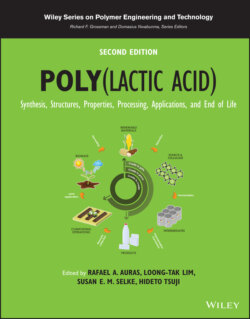Читать книгу Poly(lactic acid) - Группа авторов - Страница 105
4.6.2 Radiation Effects
ОглавлениеThe effect of radiation (γ‐ and electron‐beam) on the degradation of PLA and its copolymers received considerable attention in the past [274, 306, 307]. Irradiation of polymers generates free radicals that induce chemical changes such as chain scission and cross‐linking. The atmosphere of the surroundings, irradiation dose, chemical composition, and morphology of the polymer influence the degradation mechanism. The type of end groups, pendant units, and copolymer structure (such as aromatic or aliphatic units) showed a significant effect on the stability of the polymers toward irradiation. In aliphatic polyesters, the ester linkage and the tertiary carbons in the branched polyesters are the preferred site for the degradation. Mechanical properties and molar mass are significantly affected by radiation. Therefore, the sterilization method should be carefully chosen. Ethylene oxide is mainly used when sterilizing degradable devices, by tuning the method can implants be sterilized without influencing the polymer. Electron beams and γ‐rays are also used for the sterilization of implants [306]. Generally, a dose of 25 kGy is used for such purposes [308]. Albertsson and coworkers [309] reported that copolymerization of LLA with a small amount of CL or DXO increased the stability in comparison to PLLA. The most abundant low molar mass degradation product was identified as DXO.
